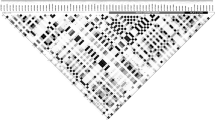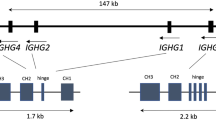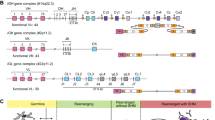Abstract
The killer immunoglobulin-like receptor (KIR) gene cluster shows extensive genetic diversity, as do the HLA class I loci, which encode ligands for KIR molecules. We genotyped 1,642 individuals from 30 geographically distinct populations to examine population-level evidence for coevolution of these two functionally related but unlinked gene clusters. We observed strong negative correlations between the presence of activating KIR genes and their corresponding HLA ligand groups across populations, especially KIR3DS1 and its putative HLA-B Bw4-80I ligands (r = −0.66, P = 0.038). In contrast, we observed weak positive relationships between the various inhibitory KIR genes and their ligands. We observed a negative correlation between distance from East Africa and frequency of activating KIR genes and their corresponding ligands, suggesting a balance between selection on HLA and KIR loci. Most KIR-HLA genetic association studies indicate a primary influence of activating KIR-HLA genotypes in disease risk1,2; concomitantly, activating receptor-ligand pairs in this study show the strongest signature of coevolution of these two complex genetic systems as compared with inhibitory receptor-ligand pairs.
This is a preview of subscription content, access via your institution
Access options
Subscribe to this journal
Receive 12 print issues and online access
$209.00 per year
only $17.42 per issue
Buy this article
- Purchase on Springer Link
- Instant access to full article PDF
Prices may be subject to local taxes which are calculated during checkout



Similar content being viewed by others
References
Carrington, M. & Martin, M.P. The impact of variation at the KIR gene cluster on human disease. Curr. Top. Microbiol. Immunol. 298, 225–257 (2006).
Parham, P. MHC class I molecules and KIRs in human history, health and survival. Nat. Rev. Immunol. 5, 201–214 (2005).
Carrington, M. & Cullen, M. Justified chauvinism: Advances in defining meiotic recombination through sperm typing. Trends Genet. 20, 196–205 (2004).
Khakoo, S.I. & Carrington, M. KIR and disease: A model system or system of models? Immunol. Rev. 214, 186–201 (2006).
Apanius, V., Penn, D., Slev, P.R., Ruff, L.R. & Potts, W.K. The nature of selection on the major histocompatibility complex. Crit. Rev. Immunol. 17, 179–224 (1997).
Borghans, J.A., Beltman, J.B. & De Boer, R.J. MHC polymorphism under host-pathogen coevolution. Immunogenetics 55, 732–739 (2004).
Hedrick, P.W. Pathogen resistance and genetic variation at MHC loci. Evolution Int. J. Org. Evolution 56, 1902–1908 (2002).
Khakoo, S.I. et al. Rapid evolution of NK cell receptor systems demonstrated by comparison of chimpanzees and humans. Immunity 12, 687–698 (2000).
Vilches, C. & Parham, P. KIR: Diverse, Rapidly Evolving Receptors of Innate and Adaptive Immunity. Annu. Rev. Immunol. 20, 217–251 (2002).
Hiby, S.E. et al. Combinations of maternal KIR and fetal HLA-C genes influence the risk of preeclampsia and reproductive success. J. Exp. Med. 200, 957–965 (2004).
Carr, W.H., Pando, M.J. & Parham, P. KIR3DL1 polymorphisms that affect NK cell inhibition by HLA-Bw4 ligand. J. Immunol. 175, 5222–5229 (2005).
Cella, M., Longo, A., Ferrara, G.B., Strominger, J.L. & Colonna, M. NK3-specific natural killer cells are selectively inhibited by Bw4- positive HLA alleles with isoleucine 80. J. Exp. Med. 180, 1235–1242 (1994).
Gumperz, J.E. et al. Conserved and variable residues within the Bw4 motif of HLA-B make separable contributions to recognition by the NKB1 killer cell- inhibitory receptor. J. Immunol. 158, 5237–5241 (1997).
Martin, M.P. et al. Epistatic interaction between KIR3DS1 and HLA-B delays the progression to AIDS. Nat. Genet. 31, 429–434 (2002).
Qi, Y. et al. KIR/HLA pleiotropism: Protection against both HIV and opportunistic infections. PLoS Pathog. 2, e79 (2006)(doi:10.1371/journal.ppat.0020079).
Bamshad, M. & Wooding, S.P. Signatures of natural selection in the human genome. Nat. Rev. Genet. 4, 99–111 (2003).
Lopez-Vazquez, A. et al. Protective effect of the HLA-Bw4I80 epitope and the killer cell immunoglobulin-like receptor 3DS1 gene against the development of hepatocellular carcinoma in patients with hepatitis C virus infection. J. Infect. Dis. 192, 162–165 (2005).
Prugnolle, F. et al. Pathogen-driven selection and worldwide HLA class I diversity. Curr. Biol. 15, 1022–1027 (2005).
Su, B. et al. Polynesian origins: insights from the Y chromosome. Proc. Natl. Acad. Sci. USA 97, 8225–8228 (2000).
Meyer, D., Single, R.M., Mack, S.J., Erlich, H.A. & Thomson, G. Signatures of demographic history and natural selection in the human major histocompatibility complex Loci. Genetics 173, 2121–2142 (2006).
Hedrick, P.W., Whittam, T.S. & Parham, P. Heterozygosity at individual amino acid sites: extremely high levels for HLA-A and -B genes. Proc. Natl. Acad. Sci. USA 88, 5897–5901 (1991).
Salamon, H. et al. Evolution of HLA class II molecules: allelic and amino acid site variability across populations. Genetics 152, 393–400 (1999).
Osier, M.V. et al. ALFRED: An allele frequency database for anthropology. Am. J. Phys. Anthropol. 119, 77–83 (2002).
Martin, M.P. & Carrington, M. KIR locus polymorphisms: Genotyping and disease association analysis. in Methods in Molecular Biology: Innate Immunity (eds. Ewbank, J. & Vivier, E.) (Humana Press, Totowa, New Jersey, in the press).
Martin, M.P. et al. Cutting edge: Susceptibility to psoriatic arthritis: Influence of activating killer Ig-like receptor genes in the absence of specific HLA-C alleles. J. Immunol. 169, 2818–2822 (2002).
Lancaster, A., Nelson, M.P., Meyer, D., Thomson, G. & Single, R.M. PyPop: a software framework for population genomics: analyzing large-scale multi-locus genotype data. Pac. Symp. Biocomput. 514–525 (2003).
Single, R.M., Meyer, D. & Thomson, G. Statistical methods for analysis of population genetic data. in Immunobiology of the Human MHC: Proceedings of the 13th International Histocompatibility Workshop and Conference Vol. 1 (ed. Hansen, J.A.) (IHWG Press, Seattle, 2007).
Williams, R.C., Steinberg, A.G., Knowler, W.C. & Pettitt, D.J. Gm 3;5,13,14 and stated-admixture: independent estimates of admixture in American Indians. Am. J. Hum. Genet. 39, 409–413 (1986).
Cramer, H. Mathematical Methods of Statistics (Princeton Univ. Press, Princeton, New Jersey, 1946).
Fisher, R. Statistical Methods for Research Workers (Oliver & Boyd, Edinburgh, 1970).
Acknowledgements
We thank H. Rajeevan and M. Osier for their assistance with the ALFRED database. This project has been funded in whole or in part with federal funds from the US National Cancer Institute (National Institutes of Health) under contract N01-CO-12400. The content of this publication does not necessarily reflect the views or policies of the Department of Health and Human Services, nor does mention of trade names, commercial products or organizations imply endorsement by the US Government. This research was supported in part by the Intramural Research Program of the US National Institutes of Health (NIH), National Cancer Institute, Center for Cancer Research. R.M.S. was supported by NIH grant GM35326, Department of Energy grant DE-FG02-00ER45828 and the Vermont Advanced Computing Center under NASA grant NNG-05GO96G. D.M. was supported by FAPESP grant 03/08973-6.
Author information
Authors and Affiliations
Contributions
M.C. designed and supervised the project and prepared the manuscript; R.M.S. contributed to the design of the project, developed the statistical methods and prepared the manuscript; M.P.M. performed KIR genotyping and prepared the manuscript; X.G. performed HLA genotyping; D.M. and M.Y. provided intellectual input; J.R.K. and K.K.K. provided samples and intellectual input; all authors discussed the results and commented on the manuscript.
Corresponding author
Ethics declarations
Competing interests
The authors declare no competing financial interests.
Supplementary information
Supplementary Text and Figures
Supplementary Note, Supplementary Figure 1 (PDF 85 kb)
Rights and permissions
About this article
Cite this article
Single, R., Martin, M., Gao, X. et al. Global diversity and evidence for coevolution of KIR and HLA. Nat Genet 39, 1114–1119 (2007). https://doi.org/10.1038/ng2077
Received:
Accepted:
Published:
Issue Date:
DOI: https://doi.org/10.1038/ng2077
This article is cited by
-
Immunity and mental illness: findings from a Danish population-based immunogenetic study of seven psychiatric and neurodevelopmental disorders
European Journal of Human Genetics (2019)
-
KIR gene presence/absence polymorphisms and global diversity in the Kirgiz ethnic minority and populations distributed worldwide
Molecular Biology Reports (2019)
-
Discovery of gorilla MHC-C expressing C1 ligand for KIR
Immunogenetics (2018)
-
KIR2DL2/C1 is a Risk Factor for Chronic Infection and Associated with Non-response to PEG-IFN and RBV Combination Therapy in Hepatitis C Virus Genotype 1b Patients in China
Virologica Sinica (2018)
-
Gorilla MHC class I gene and sequence variation in a comparative context
Immunogenetics (2017)



